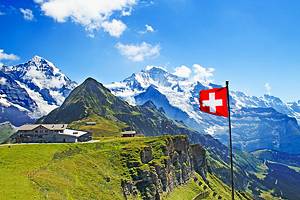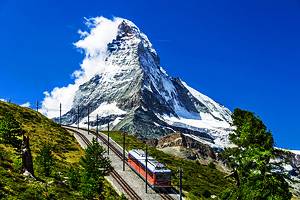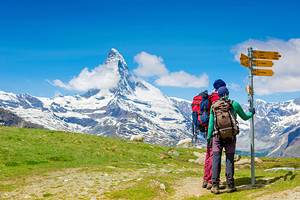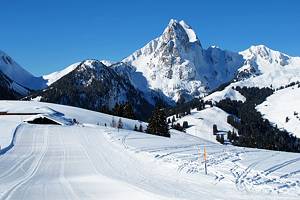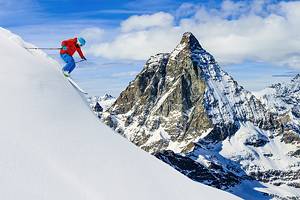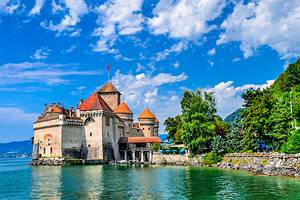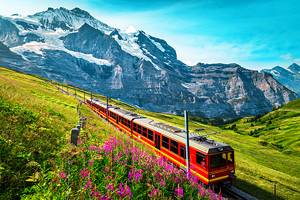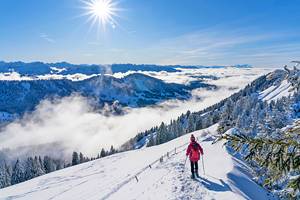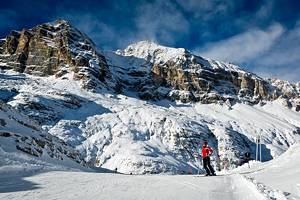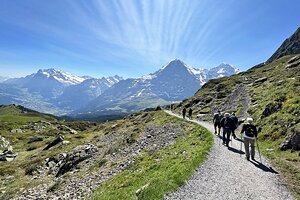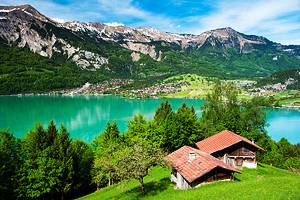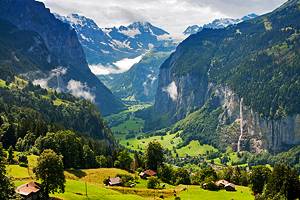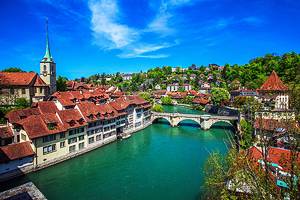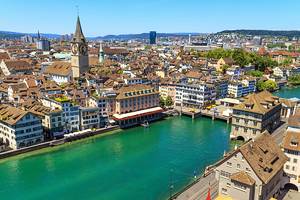Hikes in Switzerland
Home to the Alps, picturesque wooden bridges and huts, snowcapped mountains, and the deepest blue lakes, Switzerland is a hiker's paradise. Epic trails cut through the country – from easy trails for solo travelers and families to strenuous paths that get you to the top of mountains for the best Alpine views.
From short hikes to all-day treks, here are some of the best hiking trails in Switzerland.
Mount Rigi Panorama Trail
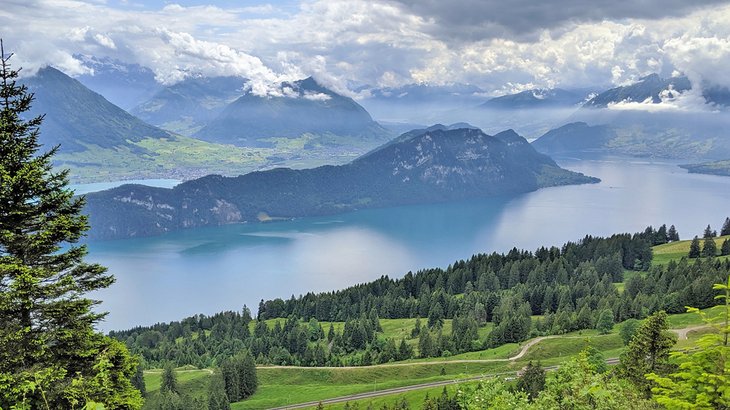
An easy, mostly flat (except for some short steep sections), seven-kilometer hike, the Rigi Panorama Trail offers some of the best views you'll find while hiking Switzerland. Most of the trail is dirt and gravel, but the path is well-maintained to make it easy to maneuver at any time of the year.
The trail starts already high up, at the top of Rigi Kulm, right at the mountain train station line. The views from here are already stunning, opening over green and blue valleys and clouds. Find a bench, grab a coffee, or just snap pictures until you're ready to start going.
Start by following the signs pointing to Rigi. You'll be walking near the train tracks for a while, until the trail splits - at that time, take the left trail and keep walking. It's hard to pick the best view along the way - the green flowering valleys, the Goldau mountain in the background, or the blueish peaks in the distance. As you keep walking, you'll see smaller trails splitting off to the sides. Most of these are short, so you can get off the main trail, explore for a bit, and then return to the main path.
Continue following the signs to Rigi Scheidegg and see if you can find an empty bench when you reach the Felsenweg area - the view right over the water and the peaks in the distance is stunning and the perfect spot for a quick lunch or just a break.
Once you get closer to Scheidegg, you'll see that the trail splits in two - one slightly bumpier and steeper than the other. Both trails eventually lead to the same place, so take the one with the higher elevation if you can - the views are clearer and more open on that one.
The trail ends right before the Rigi Scheidegg cable car. You can spend some time at the station visiting the restaurant before you take the cable car back down to the valley, where you can catch a train to wherever it is you're going next.
- Read More: Tourist Attractions in Lucerne
Engelberg Valley
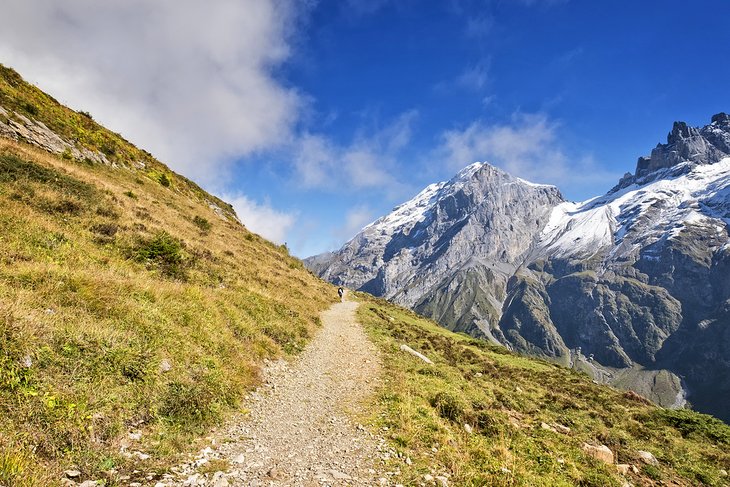
The Engelberg Valley has so many trails, you could spend weeks hiking through it and still have corners left to explore. The Brunni Trail is a panoramic path and a great way to help you discover the basics of the valley and the flowering pastures surrounded by towering peaks. This seven-kilometer hike sees little elevation (just under 300 meters total) and shouldn't take more than two-and-a-half hours to complete.
The easiest walk to set on this trail is to take the Brunni cable car to the Ristis station. Once you exit the station, you'll see signs for the Brunni Trail - get on it and start walking in the Rigidalalp direction. This is an education trail, so you'll find panels with information about the surrounding plant species covering the meadows.
Continue on the trail until you reach the Brunnihütte refuge. This is the perfect spot for a break, as the views of Mount Titlis and Lake Härzli are stunning from here. The refuge is also home to a small restaurant offering Swiss specialties, including local sweets and cheeses.
For a fun experience, try the BrunniTickle path, a special path that surrounds the entire lake, meant to be experienced without shoes on. The trail is made up of a number of textures: sand followed by gravel followed by wood chips. There's soft terrain followed by water-covered ground and then prickly ground.
Head back down to Ristis the same way you came up, then take the cable car back to the village.
Matterhorn
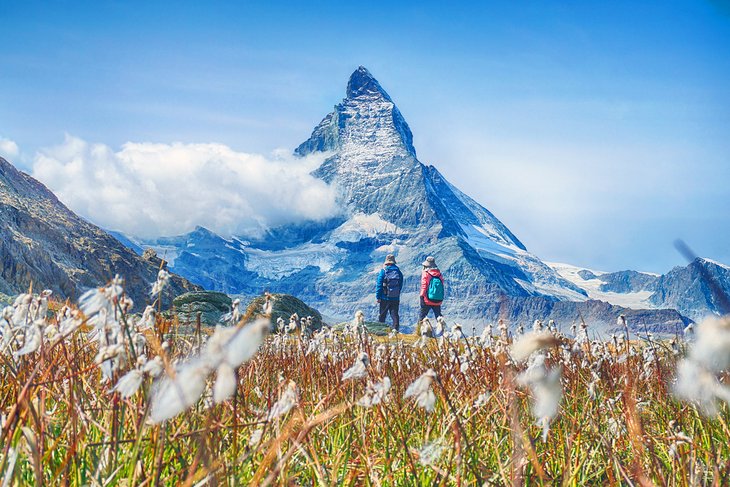
The Matterhorn is one of the highest summits in the Alps. For hikers who want to test themselves, it doesn't get much harder than trekking up part of the 4,478 meters of the mountain that sits right on the border between Switzerland and Italy.
Technically a moderate hike, getting up the Matterhorn will take eight to 12 hours, depending on fitness, stops, and a few variations on the route along the way.
The city of Zermatt is the best starting point for Matterhorn hikes. If you want to keep this to a one-day hike, set off as soon as the sun rises, find the cable car line, and start hiking up following it. After three hours of a very steep and straight path with stunning views over blue mountains, you'll reach Schwarzsee Paradise, a hotel/restaurant where you can stop for a bite before continuing on. You are technically not on the Matterhorn yet, but this is the quickest way to get you high enough to connect to the following trail.
From here, it's a surprisingly flat, one-hour hike along the Matterhorn side. Weather starts to change at this altitude but it's also the last bit of "easy" hiking, so it's a good time to enjoy the surroundings. After about an hour (if you don't take any breaks), the terrain gets difficult again - expect lots of slippery rocks, very steep rocks that require some maneuvering, and lots of good balance.
After 90 minutes of this, you'll reach the Hörnli Hut, the sleeping hut for the Base Camp at the Matterhorn - this is where multi-day trekkers spend the night before continuing on. Take a break here to admire the cloud-covered peaks and the Matterhorn up close - on clear days, it feels like you can almost touch the summit.
From here, the trail actually heads down for a nice break until you reach the Glacier trail, where you have a direct, open view of the snow-kissed Matterhorn and the other mountains around it. This trail is rocky and slippery but flat - at a steady pace, it should take you two hours to travel to the end of it, where you'll find a cable car station.
Unless you want to overnight on the mountain, end the hike here, and jump on the cable car to get back to Zermatt.
Something to keep in mind: even in summer, it gets cold on the Matterhorn. With a hike this long, you will need to take along a jacket and possibly layers to stay comfortable the entire way.
Lauterbrunnental Glacial Valley
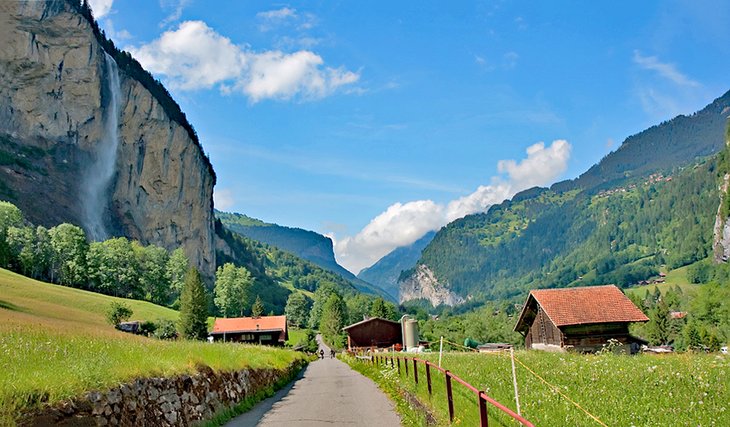
Lauterbrunnental is known as the valley with the 12 waterfalls, so a hike here will get you stunning views no matter which way you're heading. This is an excellent destination for quick, easy hikes, as the valley slopes softly, and the green meadows offer good traction and make the terrain comfortable for treks.
Start your hike at the train station in Lauterbrunnental. You'll see signs pointing out to the trails - just get on the cement path and start walking south. After about 15 minutes, the paved road ends, and you'll be walking on a sandy road with almost no elevation. The next 45 minutes are full of waterfalls tumbling down steep snow-covered cliffs, rivers, and waterways, and plenty of cows grazing in the distance.
Once you see a split in the road (about an hour after leaving the train station) with a sign pointing to the town of Stechelberg, ignore it and take the second path. This will take you on a slightly steeper trail in the direction of Gimmelwald. The first part of the hike is mostly through shaded forest and past rivers before it opens up over flowering meadows surrounded by mountains and some of those stunning waterfalls the valley is famous for.
Follow the signs pointing to Gimmelwald, one to two hours away depending on how often you stop to take pictures or dip your toes in the river. You'll eventually see the tiny mountain village of Gimmelwald emerge among the snow-covered peaks - there are a couple of restaurants, a hostel, and some shaded spots for a break again here.
From here, you can continue on to Murren to catch the train back or turn around to find your way to Lauterbrunnental again.
- Read More: Tourist Attractions in the Jungfrau Region
Höhbalmen Alpine Meadows
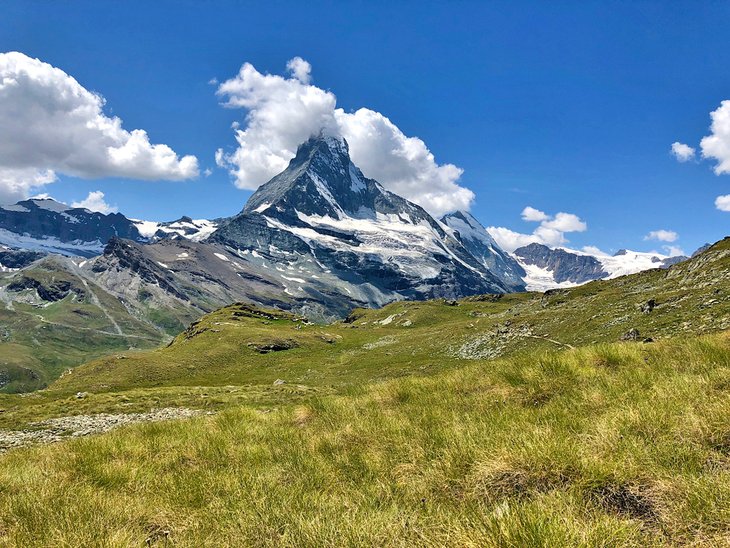
Just minutes outside Zermatt - one of the most famous mountain resort towns in southern Switzerland - is the Höhbalmen Alpine meadow, a wildflower-covered balcony with a direct view over the Valais Alps. The Höhbalmen-Höhenweg hike, which takes you right past the northern face of the mighty Matterhorn, is perhaps one of the most beautiful hikes in the area - if you're up for the challenge.
A tough 18-kilometer hike that starts at an altitude of 1,605 meters and goes up to 2,740 meters at one point, this trail takes you past sparse forests, meadows where sheep graze, a water reservoir, and views down over Zermatt.
The trail crosses valleys and hillsides, before starting a descent towards Schwarzlager, passing by a roaring waterfall before taking you right by a restaurant, where you can take a break for lunch or an early dinner before continuing on for another 45 minutes to Zermatt.
Mount Titlis
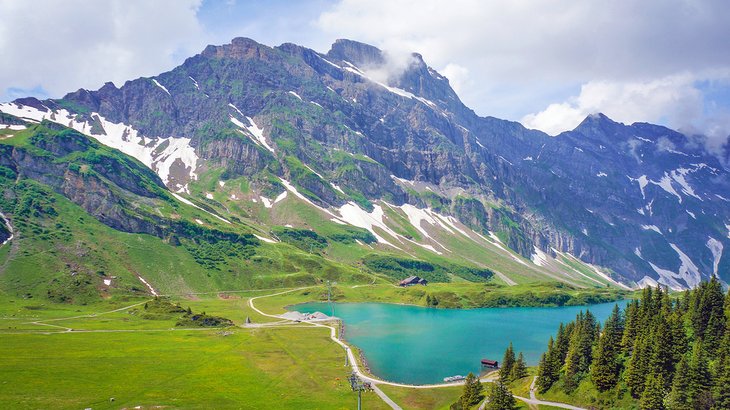
If the idea of hiking the Mattherhorn seems too daunting, Mount Titlis in the Uri Alps is a much more approachable option. Even better, the mountain offers several trails that go from easy one-hour walks to advanced level hikes that can get you to the top of the 3,000-meter-tall mountain - all along a stunning scenery of Alpine flowers and sloping, green meadows.
For an easy hike without sacrificing views, you can try the one-hour-long Trubsee Circular Trail that takes less than one hour to complete and offers several fire pits along the way (bring a picnic) and a lakeside rest area.
Another easy (but much longer) hike is the Marmot Trail, which starts at the Trübsee mountain station and requires a chairlift up a hill to reach the start of the trail - this hike, which takes about five hours, gives you a direct view over the deep-blue waters of Engstlensee lake.
The Lake Trüb trail at the bottom of Mount Titlis is a great option for a winter hike. It entails a three-kilometer-loop around Trübsee lake on trails that are well-groomed, even when packed with snow. It's an easy, relaxed hike with a background of rugged mountains and soft sloping hills.
Parc Ela
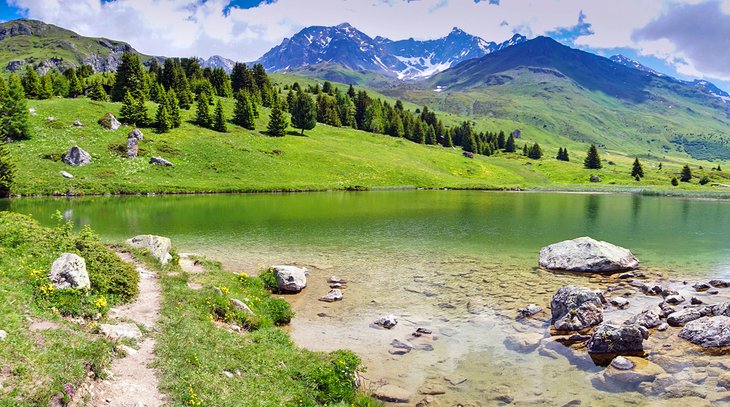
Parc Ela is a large stretch of untouched nature in the heart of the canton of Graubünden, the easternmost region of Switzerland. Although there are many hikes here, the Hängebrücke Val Meltger trail is a great place to start. An eight-kilometer, mostly gravel path with a total elevation of almost 400 meters, this hike offers great open views over the valley of Oberhalbstein.
The trail starts at the village of Lantsch, from where it ascends steeply through thick, beautiful forests. Following the path eventually gets you to the Val Meltger hanging bridge, built to replace an earlier one destroyed by an avalanche. Cross the bridge and continue on your way and you'll eventually run into a single Alpine hut - this is a favorite photo spot, with perfect views of the Engadin Alpine valley region and Julier Pass, a mountain pass famous for its serpentine road.
From here, you can start your descent through deep green woodland, crossing springs and a small picturesque lake along the way. You'll end up back in Lantsch village, not far from where you started the hike.
Oeschinensee Panorama Hike
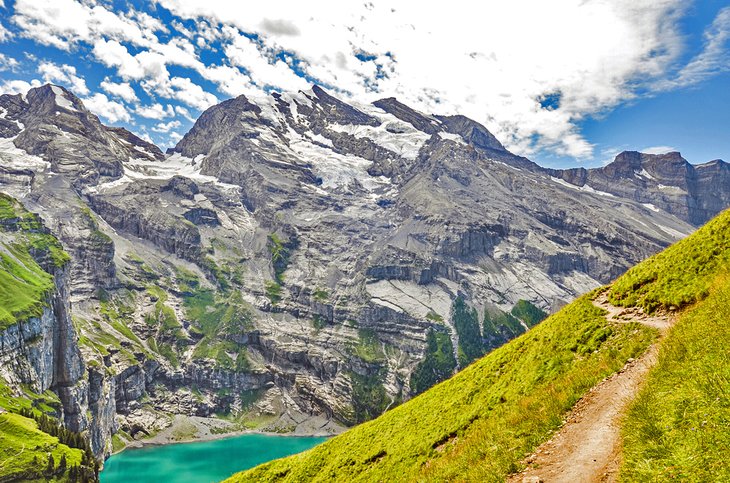
The Oeschinensee Panorama Hike is an 8.5-kilometer loop that takes you around the deep turquoise waters of Oeschinensee Lake.
Although the trail starts as a steep walk, it becomes flatter later on. You'll still have to maneuver the path's rocky ground and often maneuver around narrow and slippery corners. Good fitness is necessary to complete this hike but there are enough beautiful spots to stop for a breather along the way if necessary.
The trail starts in the town of Kandersteg, 2.5 hours from Zurich. To set off, find the Kandersteg cable car and take it up the mountain - you'll find the signs leading to the trail in the direction of Ober Bergli once you get here. This is the steepest section of the trail, with tricky footing in certain parts -but the views as you pass trickling and roaring waterfalls, snow-kissed cliffs, and flowering meadows will provide enough distraction to make the walk more than manageable.
Expect lots of adorable cows with bells peacefully feeding on the valley along the way. The path is well marked, so there's no risk of getting lost or ending up on a different trail. Once you pass the Ober Bärgli mountain hut, you'll be halfway through your hike. From here, the trail leads downhill until you reach the lakeshore.
The area will be busy, with restaurants, places for kids to play, and souvenir shops, so take a breather for the last quiet photo opportunities before you arrive. In summer, you can jump in the lake for a cold swim. After a break, head back to the cable car and down the mountain.
Via Engiadina
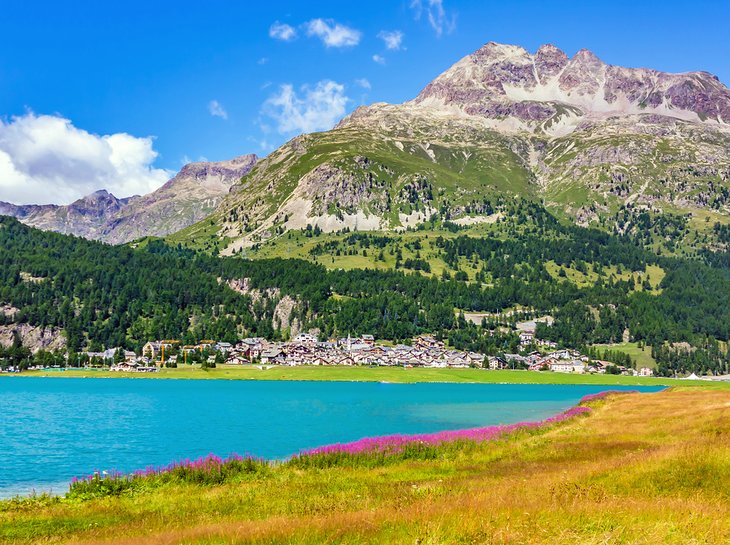
Doing the entire Via Engiadina trail is a bit of a stretch – the hike extends from Maloja to Samedan, covering 35 kilometers of paths that cross mountain pastures, thick Swiss pine forests, and tiny villages that seem untouched by time.
For a taste of what the route has to offer, you could complete Stage 1 of the hike, a moderately difficult, 11-kilometer hike that takes you from Maloja to Silvaplana. The hike starts right in the center of the tiny village of Maloja and follows a path down into the Engadin Valley, past rustic mountain huts and flowering Alpine meadows.
Continue on the trail, and you'll get to the village of Grevasalvas, the setting for the Johanna Spyri's book, Heidi. Surrounded by glaciers and open views over the Upper Engadine lake, the trail continues down till it reaches the medieval Sils-Baselgia church, then up again until you get to Silvaplana. From here, you can take the train back to Maloja.
Val Trupchun Hiking Trail, Swiss National Park
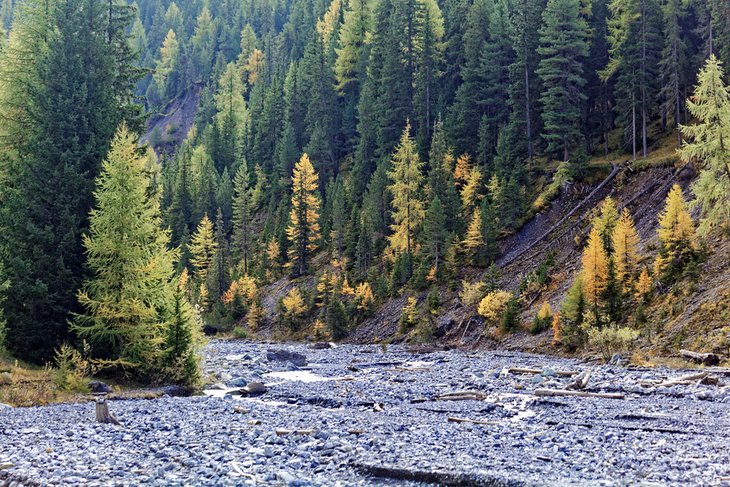
Part of the UNESCO Biosphere Reserve, the Swiss National Park is technically the only national park in the country - the rest of the protected areas in Switzerland are preserves or nature parks.
The park's Val Trupchun trail is one of the most popular paths in Switzerland. Val Trupchun is a 14-kilometer hike, but don't let that scare you – with moderate terrain and an ascent of just over 600 meters over a four-hour-and-20-minutes period, this is a very doable hike with stunning views and a chance to run into red deer, ibex, and maybe even the rare Swiss bearded vulture.
To start the hike, make your way to the Prasüras car park - you don't need a car to get here, as local and tourist buses use it as a stop. To get inside the park itself, you'll have to take the right-side trail that starts here and follow it until you cross the Punt da Scrins bridge. You'll walk into the park itself soon after. From here, you'll see the valley ahead, so keep walking into it - this is the best area to spot wildlife, so keep your eyes open.
Follow the trail towards Ova da Trupchun. Once you cross a wooden bridge, you'll be back on the trail itself and should see trail markers to help you continue on your way. You'll find two resting spots on the trail - easy to identify by benches, with some of the best open views over the valley and areas where wild animals congregate. After this, the trail starts to turn back towards the Prasüras car park.
Hardergrat Trail
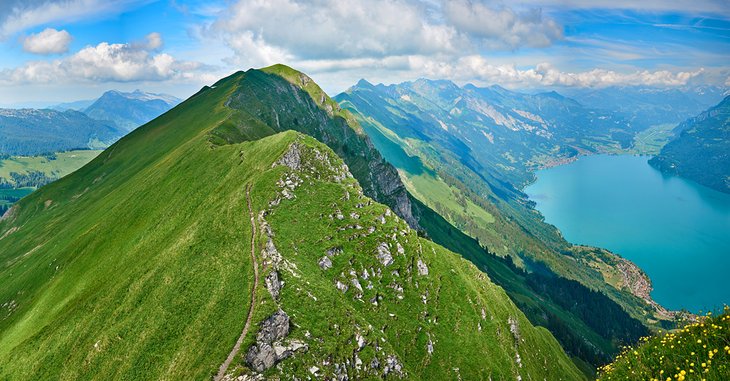
The Hardergrat Trail isn't short or easy, but even in a country filled with beautiful hikes, it offers breathtaking panoramic views. This isn't a hike for the faint of heart (or those with a fear of heights) either. Much of the trail is on a narrow ridge, with very steep falls on both sides, and requires holding on to cables. In short: don't attempt on rainy days, and make sure your fitness level is up for it.
The entire trail runs from Interlaken to Brienzer Rothorn, a 23.3-kilometer route with an elevation gain of over 2,400 meters. There's signage all along the way, and it's basically impossible to lose the trail, as most of it is on narrow ledges with nowhere else to go.
If that sounds too daunting, you can certainly hike only parts of it. For example, it's possible to take the cog train up to Brienzer Rothorn then hike toward Harderkulm and end the hike by taking the gondola down into the city.
If you hike the entire trail, expect to need anywhere between 10 and 13 hours, depending on how frequently you stop. There are plenty of reasons to stop along the way to catch the views, though, as you're surrounded by some of the most magnificent peaks in the Jungfrau area.
Read More: Attractions & Things to Do in the Jungfrau Region
Bernese Oberland Day Hike
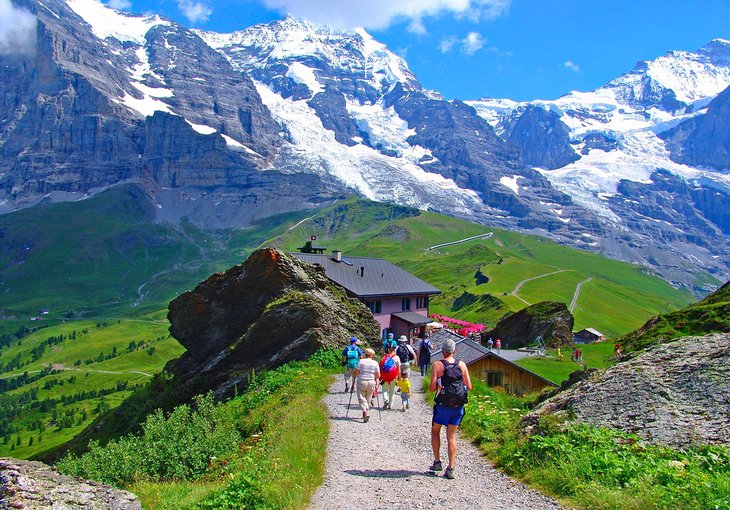
The Bernese Oberland is one of Switzerland's most outstanding regions. It includes some of the highest peaks of the Bernese Alps and stunning views in every direction, so a day hike here is hard to beat.
A great Bernese Oberland 10-kilometer hike you can complete in about three to four hours starts at the Schynige Platte viewpoint in the Bernese Highlands. You can reach the starting point via the Schynige Platte railway. From here, it's an easy, leisurely walk over green slopes filled with wildflowers before the terrain starts to get steep as you approach Loucherhorn (there are signs everywhere to point you in the right direction). You'll have great views over the Jungfrau mountain range all along the way.
Right before Loucherhorn, you'll have a chance to take the Panorama Trail or continue on towards Faulhorn – you want the second option. The terrain gets rockier after this, with plenty of boulders and slippery ledges. Even in summer, there might still be snow on the ground, so the steep terrain can be quite difficult at times.
Five kilometers into this hike, you'll reach the Männdlenen mountain hut, where you can stop for lunch and to recharge before the very challenging second half of the hike. The trail to the top of Faulhorn is narrow and tiring, but you'll be rewarded with stunning 360-degree views over the mountain peaks around.
Map of Hikes in Switzerland
More Related Articles on PlanetWare.com
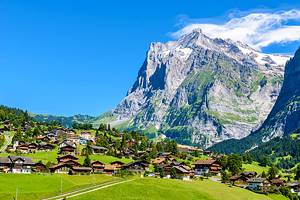
Discovering Switzerland: Hiking is one of the most popular outdoor activities in Switzerland, but the country also offers great urban fun, lakes to swim on, and much more. Take a look at our article on the Tourist Attractions in Switzerland to find more things to do.
If you're visiting in winter, the mountains offer plenty of snow fun, as you can see in our Ski Resorts in Switzerland article.


